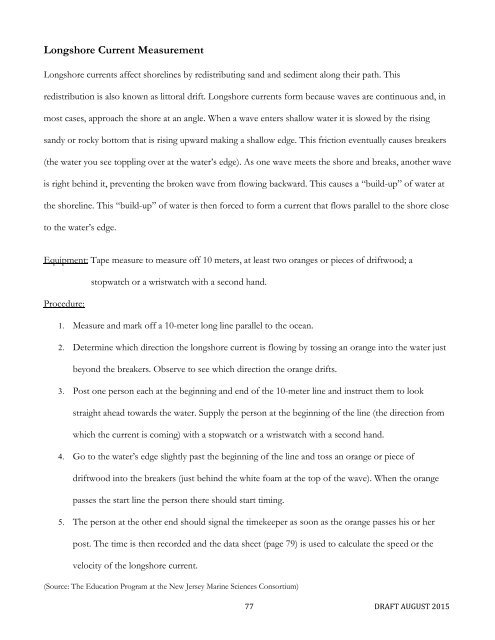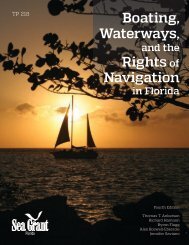Adopt-A-Wetland
XQDrg
XQDrg
Create successful ePaper yourself
Turn your PDF publications into a flip-book with our unique Google optimized e-Paper software.
Longshore Current Measurement<br />
Longshore currents affect shorelines by redistributing sand and sediment along their path. This<br />
redistribution is also known as littoral drift. Longshore currents form because waves are continuous and, in<br />
most cases, approach the shore at an angle. When a wave enters shallow water it is slowed by the rising<br />
sandy or rocky bottom that is rising upward making a shallow edge. This friction eventually causes breakers<br />
(the water you see toppling over at the water’s edge). As one wave meets the shore and breaks, another wave<br />
is right behind it, preventing the broken wave from flowing backward. This causes a “build-up” of water at<br />
the shoreline. This “build-up” of water is then forced to form a current that flows parallel to the shore close<br />
to the water’s edge.<br />
Equipment: Tape measure to measure off 10 meters, at least two oranges or pieces of driftwood; a<br />
stopwatch or a wristwatch with a second hand.<br />
Procedure:<br />
1. Measure and mark off a 10-meter long line parallel to the ocean.<br />
2. Determine which direction the longshore current is flowing by tossing an orange into the water just<br />
beyond the breakers. Observe to see which direction the orange drifts.<br />
3. Post one person each at the beginning and end of the 10-meter line and instruct them to look<br />
straight ahead towards the water. Supply the person at the beginning of the line (the direction from<br />
which the current is coming) with a stopwatch or a wristwatch with a second hand.<br />
4. Go to the water’s edge slightly past the beginning of the line and toss an orange or piece of<br />
driftwood into the breakers (just behind the white foam at the top of the wave). When the orange<br />
passes the start line the person there should start timing.<br />
5. The person at the other end should signal the timekeeper as soon as the orange passes his or her<br />
post. The time is then recorded and the data sheet (page 79) is used to calculate the speed or the<br />
velocity of the longshore current.<br />
(Source: The Education Program at the New Jersey Marine Sciences Consortium)<br />
77 DRAFT AUGUST 2015



